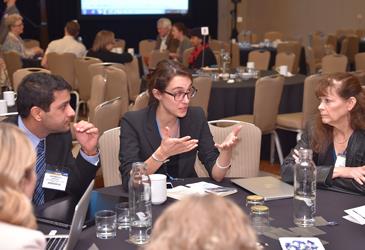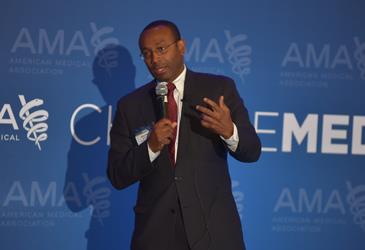Faculty and students from more than 110 medical institutions discussed the future of physician education last week at the AMA’s CHANGEMEDED conference. The three-day event culminated in an “unconference,” a special session in which conference participants voted for the topics to explore further. Want to be part of the solution? Check out the topics that ranked on this med ed agenda to determine whether any align with special initiatives at your school.
The final day of CHANGEMEDED featured an “unconference”—a special session for attendees to discuss and explore practical applications from the main conference presentations.
The unconference generated “important conversations without the use of a formal agenda or stated purpose or theme,” according to a report issued after the event. To determine topics for discussion, participants had to submit answers to the question: What does the medical school of the future look and feel like—and how do we get there?
Participants posted their answers to a cloud site designed for the event. Within seconds, ideas poured in. Some participants envisioned a virtual medical school without walls or buildings. Others asserted that developing new med school curriculums would spark breakthrough innovations in health care, science and technology.
Unconference attendees proposed and voted for the topics they deemed germane to innovating future physician training. Of several dozen proposed issues, participants agreed that the transformation of medical education relies on schools addressing:
New ways to make medical training more patient-centered
Keeping the patient at the center of care is the primary concern of good physicians. That’s why participants recommended that schools incorporate clinical exposure, patient learning and health systems science into medical school curriculums early in the curriculum.
Schools should embed students in health care systems, teach team-based care and stress the crucial link between population health, social determinants and patient care, according to session discussions.
How to exclude redundant information from a redesigned curriculum
Is there a way to integrate basic and clinical sciences more effectively in clinical rotations? Should schools derive curriculum content based on core concepts from the USMLE? To address these questions, conference participants shared ideas on how schools can launch creative programs that combine basic sciences with clinical training without overloading students with information.
When determining which subjects to prioritize in school curriculums, the group’s consensus was truthful: “Hard choices must be made. Be honest with faculty,” they said.
Strategies for increasing diversity in medical education
Research shows that diversifying the physician workforce can help reduce health disparities. Yet the percentage of students from underrepresented groups in medicine—particularly among blacks and Hispanics— increased by less than two percent in 2014 and has actually decreased since 1978 for black men.
“Professional mentorship is one strategy that can help,” said Dawn Morton-Rias, EdD, president and chief executive officer of the National Commission on Certification of Physician Assistants.

“Can [schools and programs] incentivize mentorship? Maybe,” she said. “But it has to be in the souls and hearts of physicians to give back …. Some of my greatest mentors didn’t even know they were mentors to me because I worked with them in different contexts.”
Mentoring minority students and leaders across the health care profession allows physicians to deepen their interprofessional knowledge and expand their network, she said.
Group participants also discussed programming solutions, such as pipeline education initiatives to support students of color through undergraduate and graduate medical education.
Creating specialized curriculums for a “medical school without walls”
For students and faculty to thrive, medical schools should create highly individualized curriculums that focus on personalized learning, participants suggested.
This concept relates to a broader theme of “decentralizing medical schools,” so that students aren’t confined to training within the walls of one institution.
“Every medical school can’t be excellent at everything,” said Suraiya Rahman, MD, an assistant professor at the University of Southern California Keck School of Medicine.
Instead, medical schools should harness the strongest aspects of their curriculums to create “centers of excellence” in which students can freely study a specialized aspect of medicine. This also allows students to move fluidly through a “network of centers across the country” to “build their own education,” according to recommendation from Dr. Rahman and her discussion group.
“Let’s say I want to create information technology in medicine or want to go to a center where [video] games are being made,” she said. “I happen to be fortunate enough to [be at] USC, but what if someone over at Hofstra doesn’t have [videogames in their curriculum]? Why can’t they just come over to USC to take courses?” she said, noting that schools can build connective structures to support large networks of external students and faculty.
Health care delivery science and the physician of the future
That’s the term that should come to mind when educators describe future physicians who master health care delivery science, according to participants.
The group discussed various competencies students should demonstrate in health care delivery science, such as building emotional intelligence, strengthening interpersonal skills and conducting patient-centered care based on recommendations from the Institute of Medicine.
How massive open online courses fit into future medical schools
E-learning modules. Open source sites. Instructional videos. These are common staples of MOOCs, yet many schools struggle to successfully integrate these new technologies into existing curriculums.
While online courses can be a great way to supplement student learning, educators are concerned about technology displacing traditional lectures, which often allow them to connect with students, according to session discussions.
“There are many online resources that are available, and it’s within faculty means to create good online resources, but some faculty members really crave that connection with their students and don’t want that to disappear,” one commenter admitted to the group. “Some faculty are worried about being marginalized, where if they just create a library of online content, they won’t be needed any longer.
Schools can help faculty overcome this fear by restructuring their curriculums to give them incentives for using online tools. Educators also should train themselves to comfortably teach using different modalities, the group recommended.
The challenges new medical schools encounter as a result of limited time and funding for programs
These challenges are especially salient for clinicians who often lack the resources or time to be involved with students during their first two years. There’s too much emphasis on the idea that “clinicians need to be in the clinic only,” the group noted.
To combat this, school leaders must understand the value of increasing clinician training for students early in medical school. Leveraging resources and networks within the AMA to help new schools garner support for faculty also ranked high on the group’s list of recommendations.
Whether Step 1 of the United States Medical Licensing Examination should be pass or fail
Is the USMLE harming or helping medical students prepare for residency? Recent research published in Academic Medicine suggesting a revaluation of the exam sparked controversial debate among attendees.
Representatives from the National Board of Medical Examiners, students, and residency and medical school faculty discussed the exam.
“When you’re having a conversation like this, it’s important to have all the stakeholders at the table,” Alma Littles, MD, chief academic officer for the College of Medicine at Florida State University, said.
“Each stakeholder has a different take on the issue, but one of the common themes [our group] feels [is] that major stakeholders should at least consider shifting [the exam] to a pass or fail structure,” Dr. Littles said.
For instance, students at the conference said the pressure to earn high USMLE scores drives them to supplement their medical training with a “parallel curriculum” consisting of commercial USMLE preparation materials. This distracts first- and second-year students from learning beyond basic sciences and test preparation.
Yet program directors consistently rank USMLE Step 1 exam scores as a determining factor for selecting residency applicants. The exam’s impact on the selection process for diverse residents also surfaced in conversation.
Effective ways to shorten student training
Unconference participants discussed the most effective ways to immerse students in experiential learning and build competencies early in training.
The group cited Oregon Health & Science University’s new curriculum as an example of programming solutions schools can implement to assess students based on their individual strengths—not prescribed times.






